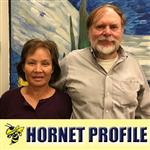1971 Hillabrand, Stephen W.
 1971 Stephen W. Hillabrand
1971 Stephen W. Hillabrand
Six days after graduation from HHS, Jim Marvin and I, enlisted in the Air Force. Three years and six months later I got out of the Air Force. My last base was in Thailand and I met Tewie (my wife). In the first six months of 1975 I came back to Hillsdale and I realized Tewie wouldn’t like Michigan winters and so I moved to LA. After the Air Force I attended a vocational school called “Computer Learning Center” in the Los Angeles area (back in the day with punch cards & tapes). After completion of that class, I got a job at JPL (Jet Propulsion Lab) in California and have been working there ever since. Later I studied at Valley College, earned AA from Glendale College, and then BA in Economics from Cal State Northridge.
I started out as a contractor and moved up with various companies such as ITT and JPL. I’m actually a CalTech employee working at JPL. The first project I worked on in 1976 was Viking – the original Mars Landers. After that I got hooked up with Voyager (we recently celebrated 40 years of flights). With Voyager we cruised to Jupiter and then to Saturn, after the Saturn flyby, Voyager kept going for 40 years. After my work on Voyager, I got to work on Galileo, a Jupiter probe and orbiter for a number of years, then I was on the test team for Cassini and the plan all along was to move over to flight as a mission controller. Cassini is orbiting Saturn and it will run out of gas next soon. Interesting fact: because of Cassini we know there are over 70 moons around Saturn.
It is important for people to know that a lot of these technologies that NASA is developing are important for mankind . . . i.e. the first digital cameras were used in the satellites, the clean-room environments used for NASA spacecraft are now used in major hospitals (i.e. clean-room environments for burn victims), NASA’s continued push for use of solar panels has improved them so much that now they use them to power the space shuttles and satellites.
The current project I’m on is called DAWN. Dawn is an orbiter which is orbiting Ceres (dwarf planet) which is the biggest Asteroid in the belt (between Mars and Jupiter). It has been flying for ten years. We first cruised to Vesta (dwarf planet) and Vesta looked like a big potato. After we broke the orbit of Vesta we cruised two years to get to Ceres and we have been orbiting Ceres for a little over two years now. Through all those missions, it looks like Dawn is the last one for me. NASA headquarters has not yet decided when that will be. We have enough gas to keep orbiting for one more year, or if NASA will let us break the orbit, we will fly for 18 months and do a flyby of an asteroid called Adeona.
I have worked on and off Cassini multiple times depending on the needs. SIRTF is the infrared brother of Hubble. SIRTF trails the Earth in the same orbit and it is imaging deep space in the infrared field. I also worked for Ulysses, a solar probe (a European craft) and orbited and studied the sun.
I am a mission controller, I work on the ground, I’m a conduit to the spacecraft. Sometimes my job is boring, but boring is good, if it isn’t boring then we have problems.
Can you tell us what your time at HHS was like?
Pleasant, wasn’t the athletic type, wasn’t the nerdy type, still keep in touch with a few guys. Got a decent education. Nothing but fond memories of HHS.
Is there a teacher who had a significant impact on your life?
John Donnelly (his son is one of my buddies still today). He taught civics and economics. I actually got a degree in economics and I’m pretty good with money.
Advice for current students?
Engineering and science are important. If you are interested in anything I talked about make sure you take those classes.
Anything else?
The good mid-western philosophy work hard.

